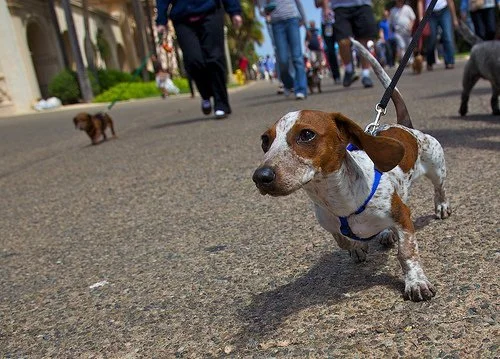Is your dog walking you? How to train your dog to stop pulling & walk politely on a leash
Whether your dog already pulls on the leash during walks, or you have a new puppy who you would like to teach to walk politely before a problem starts, the tips in this blog will help your dog become a great walking companion.
As with most behaviors, the most important thing to consider is consistency. It is important that once you begin training, you do not allow your dog to pull on the leash at any time while he is learning his new leash walking skills since allowing him to pull on the leash sometimes but not others could be very confusing (or worse, he could learn he can only pull when he doesn’t see your bait bag filled with treats!) The next most important thing to remember is that leash walking does not actually involve a leash.
Of course, you should always leash your dog so he is safe in public, but you should keep in mind the leash is not supposed to be used to physically correct your dog or drag him around. If he is focused on you and calm around distractions, he will not need to wear a leash for any reason other than safety. The goal is to set your dog up to be able to do something correctly that you can reward him for. For some dogs that already pull on the leash when walking, this might mean simply not sprinting ahead when you take one step forward. For others, this might mean you reward for any time he looks at you, or for walking a step forward with you. In the beginning, click (or use a verbal reward marker) then give a treat for anything you can: looking up to check in with you, taking a step forward calmly with you, turning when you turn, stopping when you stop, etc., and continue to click and treat for each of these things, every time your dog does them at first. Load your dog with verbal praise and "what a goooood doggie!" conversations. Try to be more exciting to your dog than all of the other potential distractions (amazing-smelling bushes, other dogs, humans, dirt, grass – the usual).
If your dog seems he is about to veer off, try to get his attention before he starts to pull on the leash by calling his name, using a cue you have trained such as "watch", showing him a treat or toy, making a smooching sound, or changing directions (without yanking on your dog) so he has to find you in order to continue. Try to do this before your dog actually pulls on the leash so he is focused as often as possible and spends very little time, if any, actually pulling while leash walking. This prevents your dog from learning to leap out to the end of the leash and then turn around to get his treat.
If your dog is already pulling, and you couldn't stop him before he started, stand still and wait for him to pay attention so that he is not rewarded accidentally as he pulls you over to the thing he wants to see. When he does pay attention, click and treat.Start your leash walking training in a small area such as your back yard, driveway, or part of your block (maybe the distance of a few houses in each direction). Then, as your dog starts to behave more calmly and is more focused while leash walking, move on to harder situations and longer walks.
It is important to do this gradually. In the meantime, give your dog his physical exercise by taking him to the dog park, on a play date with a few other dogs, to an off-leash area that is safe and legal to play in, or consider running with him if he doesn’t pull while running. If your dog needs exercise and is not able to get it in another way, consider purchasing a front clipping harness that gently and humanely helps prevent most dogs from pulling while walking. Purchasing a harness may or may not be a permanent solution for your dog depending on your goals for his walking skills, and you will likely want to continue working on rewarding his calm and focused behaviors since these will still be very important with or without the harness in the face of distractions.With practice, your dog will be able to enjoy his environment and his walks while paying attention to you and walking politely.
When you are satisfied with your dog’s behavior, you will be able to begin transitioning your dog to other types of less frequent rewards so you can take a nice walk with him without carrying your entire treat pouch everywhere you go. Remember to take your time getting to this point as you want to make sure your dog thoroughly learns how rewarding it is to pay attention to you on a walk. If you keep him wondering when he will get to eat a delicious bit of chicken or when he will get to play a quick game of tug-of-war at the corner while waiting for the stoplight, he will be sure to keep an eye on what you’re up to on the other end of the leash at all times!

